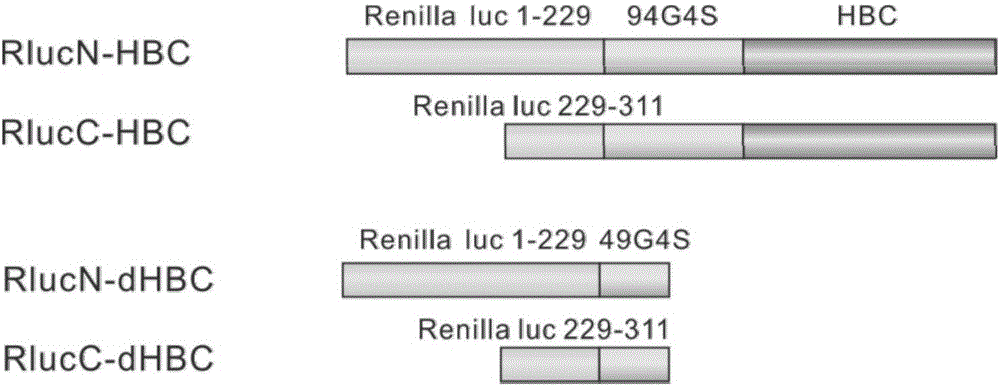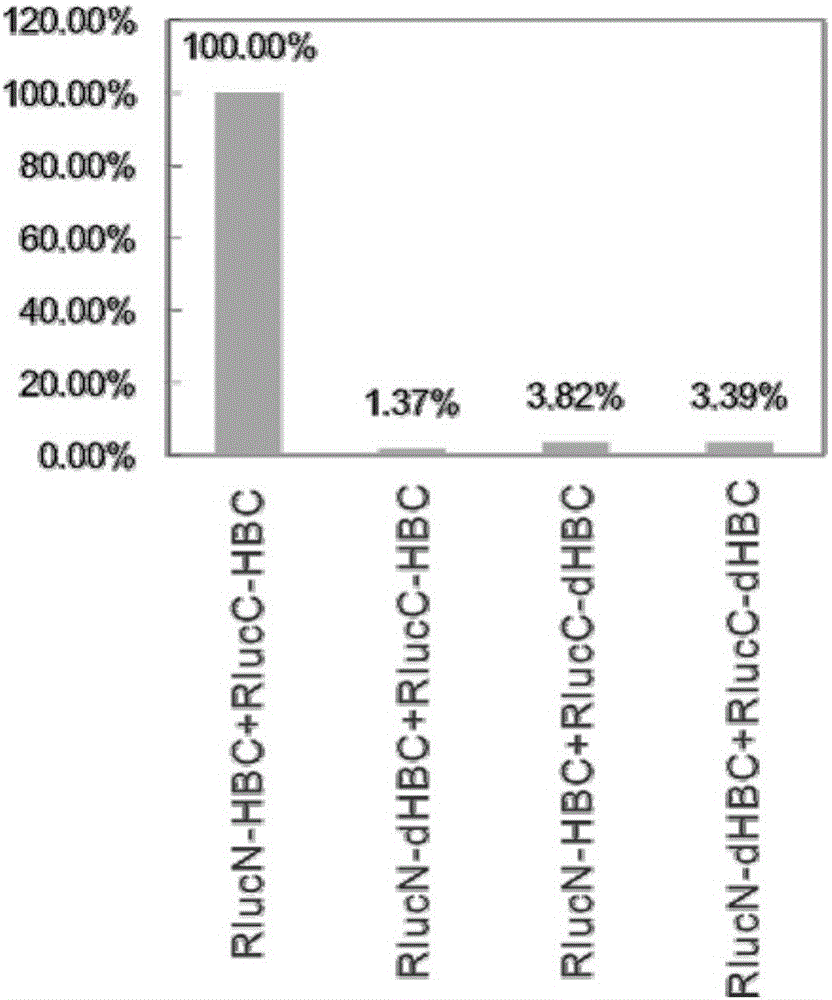Fusion protein of divisive ranilla luciferase and HBC (hepatitis B core) and application of fusion protein
A technology of Renilla luciferase and fusion protein, which is applied in the field of fusion protein, Renilla luciferase and HBC fusion protein, can solve the problems of lack of drug screening cell model, difficult analysis of conditions and mechanisms, and achieves good application value. , the effect of preventing copying
- Summary
- Abstract
- Description
- Claims
- Application Information
AI Technical Summary
Problems solved by technology
Method used
Image
Examples
Embodiment 1
[0034] Example 1: Construction of plasmid RlucN-HBC
[0035] RlucN-HBC expresses a fusion protein of hepatitis B virus core protein and Renilla luciferase N-terminal 229 amino acids. The two are connected by a 94 amino acid G4S linker (named 94G4S linker). The amino acid sequence of the 94G4S linker It is: SSGS(GGGGS)×18.
[0036] The specific construction process of plasmid RlucN-HBC is as follows:
[0037] 1. Construction of transition vector plasmid GG1
[0038] Plasmid GG1 is a transitional vector convenient for subsequent cloning operations, and its structure is as follows figure 1 As shown, GG1 contains a 94G4S linker sequence, and upstream of the 94G4S sequence is a primer sequence that facilitates PCR amplification of 94G4S. The construction process is:
[0039] Using the plasmid GFP-92G4S-HBC (this plasmid and its construction method have been disclosed in the patent application CN 201510076239.1, which is the same as the GFP-92G4S-HBc in the patent application) as a template...
Embodiment 2
[0053] Example 2: Construction of plasmid RlucC-HBC
[0054] The plasmid RlucC-HBC expresses a fusion protein of the core protein of hepatitis B virus and the C-terminal 83 amino acids (amino acids 229-311) of Renilla luciferase. The two are connected by a 94G4S linker. The specific construction process is as follows:
[0055] Carry out PCR amplification, reaction system: template PLR-TK 10ng, primers FrlucCGG (10μM) and RrlucCGG (10μM) each 1μl, 2XPrimeSTAR HS Mix 25μl, sterilized ultrapure water to make up the volume to 50μl. Reaction conditions: 95°C pre-denaturation for 3 minutes; 94°C for 15s, 58°C for 15s, 72°C for 40s, 35 cycles. The amplified fragment was recovered with a gel recovery kit, and the recovered fragment was named frag6.
[0056] The three fragments of frag6 and frag4 and frag5 obtained in Example 1 are subjected to Golden gate ligation reaction. The reaction system:
[0057] BsmB I enzyme
0.75μl
Tango buffer
1μl
DTT
1μl
T7 ligase
0.25μl
ATP
1μl
...
Embodiment 3
[0060] Example 3: Construction of plasmids RlucN-dHBC and RlucC-dHBC
[0061] RlucN-dHBC and RlucC-dHBC are based on RlucN-HBC and RlucC-HBC respectively. The HBC sequence is removed and only RlucN-49G4S and RlucC-49G4S are retained. These two plasmids will be used as negative controls. The construction adopts a single segment Golden gate connection strategy, and the specific process is as follows:
[0062] Fragment amplification reaction system: template RlucN-HBC 10ng, primers Fsv4GG2 (10μM) and Rg4sGG2 (10μM) each 1μl, 2XPrimeSTAR HS Mix 25μl, sterilized ultrapure water to make up the volume to 50μl. Reaction conditions: 95°C pre-denaturation for 3 minutes; 94°C for 15s, 58°C for 15s, 72°C for 40s, 35 cycles. The amplified fragment was recovered with a gel recovery kit, and the recovered fragment was named frag7.
[0063] The obtained fragment frag7 does its own Golden gate connection reaction, and the reaction system:
[0064] BsmB I enzyme
0.75μl
Tango buffer
1μl
DTT ...
PUM
 Login to View More
Login to View More Abstract
Description
Claims
Application Information
 Login to View More
Login to View More - R&D
- Intellectual Property
- Life Sciences
- Materials
- Tech Scout
- Unparalleled Data Quality
- Higher Quality Content
- 60% Fewer Hallucinations
Browse by: Latest US Patents, China's latest patents, Technical Efficacy Thesaurus, Application Domain, Technology Topic, Popular Technical Reports.
© 2025 PatSnap. All rights reserved.Legal|Privacy policy|Modern Slavery Act Transparency Statement|Sitemap|About US| Contact US: help@patsnap.com



